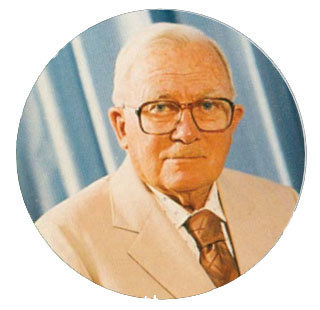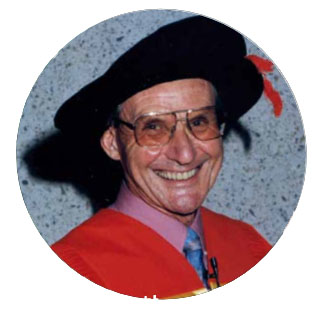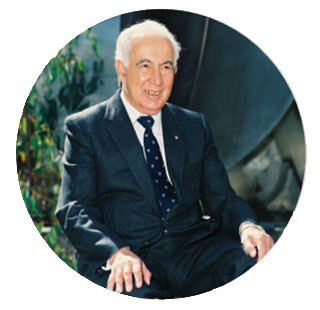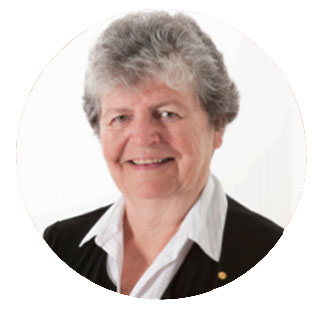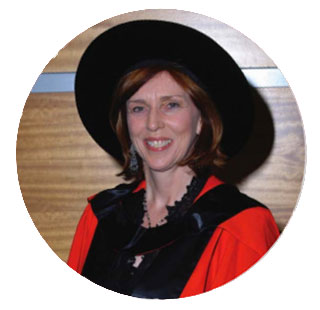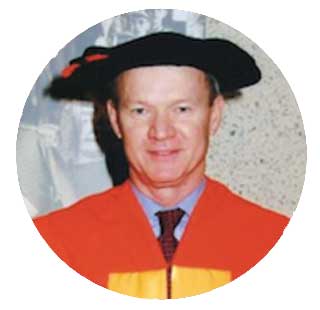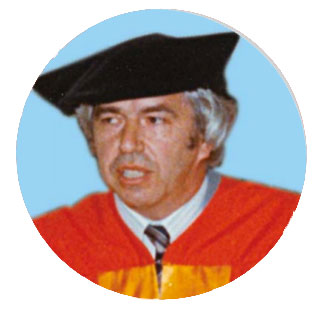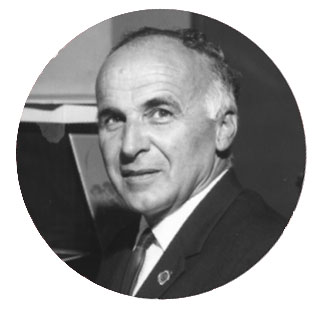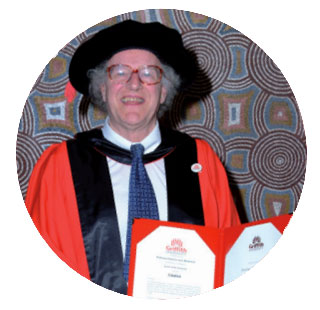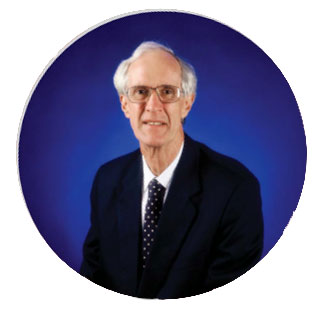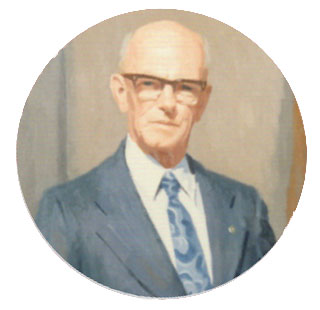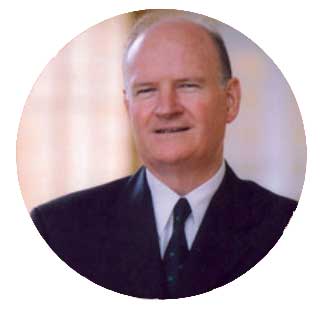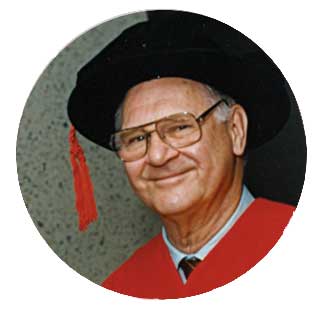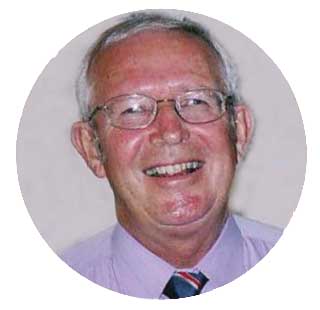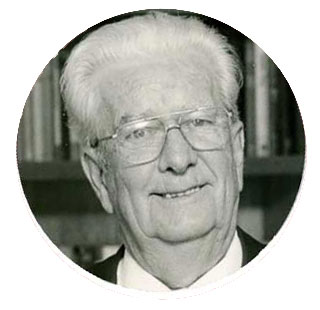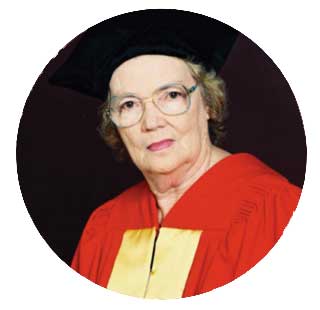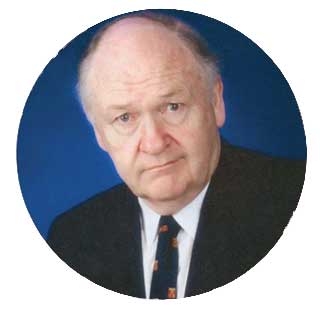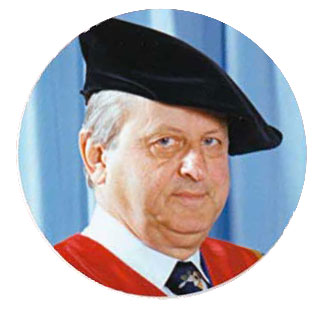The Honour Plaques were developed as a way for each campus to be able to showcase and honour Griffith people who have achieved significant success in their related fields. The University has a unique history and these plaques will assist in showcasing achievements over its long and interesting past at each campus.
The plaques provide visitors, staff members and students with a sense of how each of the campuses have developed within their respective communities and describes the contributions the honourees have made educationally, culturally and economically to the local community.
Our remarkable people
- Sir Theodore Bray
- Professor Emeritus Arthur Brownlea
- The Right Honourable Sir Zelman Cowen
- Professor Glyn Davis
- Professor Geoff Dromey
- The Honourable Ms Leneen Forde
- Professor Margaret Gardner
- Mr Wayne Goss
- Professor Emeritus Gus Guthrie
- Mr Ian Hanger
- Mr Basil Jones
- Emeritus Professor Graham Jones
- Mr John F Kearney
- Professor Emeritus Colin Mackerras
- The Honourable John Macrossan
- Professor Emeritus Phil Meade
- Ms Margaret Mittelheuser
- Mr Andrew Nimmo
- Professor John O'Gorman
- Professor Emeritus Calvin Rose
- Mr Phil Rowan
- Sir Allan Sewell
- Ms Patience Thoms
- Professor Nancy Viviani
- Professor Emeritus L. Roy Webb
- Professor Emeritus F. John Willett
Sir Theodore Bray (1905-2000)
CBE DUniv
Griffith's first Chancellor
In 1970, Sir Theodor Bray accepted the challenge of the State Education Minister of the time to plan a second University in Brisbane. From the outset, he was intimately involved in the day-to-day work and development of the University. He chaired Griffith University’s Interim Council and First Council, and was elected first Chancellor of the University in 1975. In the same year he was created a Knight Bachelor for service to education.
Under Sir Theodor’s expert guidance, Griffith was planned and began teaching in the climate of social change of the seventies. As Chancellor from 1975-1985, he was committed to establishing a university that offered an alternative higher education experience to that already available in Queensland.
This vision was reflected in Sir Theodor’s efforts to establish Australia’s first School of Modern Asian Studies. “If we do nothing else in this university,” he said, “we will teach Asian Studies and we will cultivate good relations between Asia and its neighbours around the Pacific Rim”.
In all matters, Sir Theodor made the good of Griffith University his overriding concern. His immersion in both the business and social life of the University grew from a strong sense of obligation and genuine interest and affection for the institution, its staff and students.
Professor Emeritus Arthur Brownlea (1930 – 2011)
AM
Foundation Professor, School of Australian Environmental Studies
Arthur Brownlea was appointed a Foundation Professor in the School of Australian Environmental Studies at Griffith University in 1974. In this position he was responsible for the development of the environmental, community and public health emphasis in the School. As well as supervising the University’s first PhD student, he conceived and negotiated the Masters Degree in Public Health, a collaborative offering by the three Brisbane universities supported by the State Department of Health. This collaboration was a national first for public health education in Australia.
From 1989 - 1990, Professor Brownlea served as interim Dean of the Faculty of Health and Behavioural Sciences, playing a major role in developing that Faculty’s innovative approach to the education of health and human service professionals. In addition to his significant contributions as Foundation Head of the School of Occupational Health and Safety and as Deputy Dean (Research), he was Director of two research Centres - the Institute of Applied Social Research and the Centre for Strategic Human Services. He supervised the only three PhD graduates in occupational health and safety in Queensland and won national competitive grants totalling almost one million dollars for research in erosion control, genetic manipulation, risk management, doctor patient relationships, occupational health and safety, health care in remote areas and self helping health care. Professor Brownlea’s distinguished service to community health was recognised in January 1992 when he was appointed a Member of the Order of Australia.
In recognition of his outstanding contributions to the University for over twenty years, Professor Brownlea was conferred Griffith’s honorary degree of ‘Doctor of the University’, as well as the title of Professor Emeritus, in 1996
The Right Honourable Sir Zelman Cowen
AK GCMG GCVO QC DCL DUniv
The Development of Law at Griffith
In 1990 Sir Zelman Cowen became the Vice Chancellor’s Advisor on Legal Education and a member of the Legal Education Advisory committee. This committee was responsible for the planning and development of the law curriculum for the University’s Law School. In the search for a distinctive, innovative and contemporary approach to legal education, Sir Zelman introduced the idea that the students’ courses should be integrated. This approach ultimately resulted in a law curriculum which was strongly supported by the legal profession and one that Sir Ninian Stephen hailed as a ‘revolution in legal education’. Sir Zelman chaired the Law Visiting Committee from 1992 – 2003; was a member of the Advisory Board of the Key Centre for Ethics, Law Justice and Governance 1999 - 2004 and is Patron of the Socratic Forum.
Sir Zelman’s brilliant career included terms as University of Melbourne’s Dean of Law and Vice Chancellor of University of New England then University of Queensland before serving as Governor General from 1978 to 1982. He returned to Oxford as Provost of Oriel College and Chair of the Press Council before returning to Australia and accepting the Honorary position at Griffith University.
Professor Glyn Davis
AC DUniv
Griffith's Third Vice Chancellor
Glyn Davis joined Griffith University as a lecturer in politics and public policy in 1985 and was subsequently promoted to Professor. During the 1990s he spent almost half of the decade on secondment to the Queensland Public Service rising to Director-General of the Department of the Premier and Cabinet. He took up office as the University’s third Vice Chancellor in January 2002.
Professor Davis played a crucial role in furthering the reputation of Griffith as one of the most creative and innovative tertiary institutions in Australia. He articulated a clear strategic direction for the University and reaffirmed the Griffith commitment to innovation, multidisciplinarity, internationalisation, equity and social justice, and student centred learning. A key component of the strategy was the largest capital program ever undertaken by the University. Professor Davis recognised the need for the University to expand its professional offerings with an emphasis on the health area. Under his leadership, Griffith became the first University in Australia since 1946 to introduce a comprehensive suite of oral health programs including dentistry, dental prosthetics, dental technology, and dental and oral therapy. The establishment of the School of Medicine was another major milestone in the recognition of Griffith as one of Australia’s top universities. Professor Davis also played a key role in acquiring the former South Brisbane Library as the home of the Griffith Film School.
As Vice Chancellor from 2002-2004, Professor Davis placed Griffith in a strong position to face the new millennium.
Professor Geoff Dromey (1946 – 2009)
Geoff Dromey joined Griffith University in 1986 as the Foundation Chair Professor of Computing and Information Studies. His leadership in those early years at Griffith was instrumental in laying the foundations for a number of successful programs including one of the first of two Bachelor of Software Engineering degrees in Australia in the early 1990s, and the nation’s first Bachelor of Multimedia degree in the mid-to-late 1990s. As Foundation Professor, he created a School that is today among the largest and most diverse of its kind in the nation.
Professor Dromey also set the stage for a strong research culture within the School where he was founder and Director of the Software Quality Institute, established in 1991. From early in his career, he was always passionate about research. In the 1970s he made a significant contribution in the area of software product quality through development of empirical and formal models. This work included a number of original contributions where Professor Dromey applied computer methods to chemistry and medicine. This resulted in the development of automated technology in medicine and a variety of other applications. He also made pioneering contributions in computer science, specifically in the areas of formal methods, software engineering and software quality.
In his service to the University for over twenty years, Professor Dromey provided outstanding leadership and was an inspirational force for many generations of students and staff. Through his scholarship and research, he established Griffith as an internationally recognised centre of excellence in the field of Software Engineering.
The Honourable Ms Leneen Forde
AC DUniv
The Honourable Ms Leneen Forde AC was elected as the University’s fourth Chancellor in June 2000. She was the first female Chancellor of the University and the University’s longest serving Chancellor having served in the role for fifteen years.
Over this time, Ms Forde provided outstanding leadership and guidance to Council and to University management in developing the University’s strategic direction and ensuring good governance.During her term as Chancellor, the University experienced a period of tremendous growth and expansion and enhanced its world-class reputation for undertaking high quality teaching and research.
Ms Forde was tireless in her service to and promotion of the University throughout her tenure. In addition to chairing the Griffith University Council, she also served on a range of key University committees, officiated at numerous graduation ceremonies in Australia and overseas, and was a wonderful ambassador for the University at local, national and international events. Outside the University, Ms Forde was a leading figure in the community. Following a distinguished legal career, she was appointed the 22nd Governor of Queensland in 1992 - the first ever woman to be appointed to this role in Queensland. During her five years as Governor, she travelled the State extensively to meet ordinary Queenslanders and to discuss and understand community issues. She also made a significant contribution to the reform agenda in this State through her role as Chair of the Commission of Inquiry into the Abuse of Children in Queensland Institutions.
Ms Forde’s outstanding service to the community has been extensively recognised. In 1991 she was named Queenslander of the Year; in 1993 she was awarded a Companion of the Order of Australia ‘in recognition of service to the law, to improving the status of women and to economic and business development’; in 2002 the University conferred upon Ms Forde the award of Doctor of the University; she was a recipient of a Centenary Medal in 2003; and in 2007 she was the recipient of a Queensland Greats award.
Griffith University is indebted to Ms Forde for her extraordinary contributions as Chancellor. Her hard work, dedication and commitment have been instrumental to Griffith's development and ongoing success.
Professor Margaret Gardner
AO DUniv
Margaret Gardner joined Griffith University as a lecturer in the then School of Social and Industrial Administration in July 1982. When she was appointed as Deputy Dean (Staffing) in the Division of Administration in 1989, she became the first woman in the University’s history to be appointed to that level of position. She served as Head, School of Industrial Relations from 1992-1993 and was promoted to Professor in the School in mid 1994.
From 1994-2000, Professor Gardner provided outstanding leadership in a number of senior management roles. As Pro Vice Chancellor (Equity), she was responsible for policy and planning for the University in student equity and access, equal employment opportunity, and harassment and discrimination. In this position, she implemented innovative equity policies which served as examples of best practice in Australia.
As Pro Vice Chancellor (Business) from 1996-2000, Professor Gardner played a key role in the growth of the University’s Business Group, and made major contributions to the integration and consolidation of its activities. During this period she was also responsible for Logan where she worked tirelessly to develop the new campus as a focus for creative forms of teaching and learning. In her distinguished career at Griffith, Professor Gardner set a benchmark for leadership and for the achievement of quality outcomes.
Mr Wayne Goss
DUniv
Wayne Goss was the Premier of Queensland from 1989-1996, Minister for Economic and Trade Development from 1989-1996 and Minister for the Arts from 1992-1996. Prior to becoming Premier, he was the Leader of the Opposition from 1988-1989. He represented the people of Salisbury from 1983-1986 and Logan from 1986-1998.
As Premier, Wayne Goss oversaw extensive economic and institutional change including the passage of the new Public Service Act which transformed the Queensland public service. He instituted the Fitzgerald Inquiry recommended reforms, decriminalised homosexuality and introduced electoral reform. He also introduced initiatives in areas such as education, health and the environment.
While Premier, Wayne Goss was determined to provide a university campus in Logan to provide higher education services for Logan residents and surrounding districts in the fast growing Brisbane-Gold Coast corridor. The 56ha Meadowbrook site was purchased by the Goss government for the University and the government provided significant funds towards the establishment of Logan, which was opened in 1998.
Following political life, Wayne Goss was the Chairman of the Queensland Art Gallery from 1999-2008, and the National Chairman of the business services company Deloitte Australia (2005-2013) and engineering firm Ausenco (2002-2013). He was also the Ambassador for the Australian Indigenous Education Foundation.
In recognition of his outstanding contributions to the community Wayne Goss was conferred Griffith's honorary degree of 'Doctor of the University' in 2003.
By renaming the Information Services Centre at Logan as the Wayne Goss centre in 2015, the Griffith University Council acknowledged Wayne Goss's contributions to the Logan community and his life time of extraordinary service to the people of Queensland and Australia.
Professor Emeritus Gus Guthrie
AM DUniv
Professor Gus Guthrie was one of four scholars chosen to be the Foundation Professors of the University. As Chair of the School of Science from April 1973, he was responsible for the development and growth of a new School. He immediately began to assemble a team of young and talented scholars to define and shape the School’s objectives.
The School of Science quickly established a national reputation as an innovator in university teaching and research. The outstanding performance of staff in attracting competitively awarded funds and the success of staff and students in achieving prizes and awards were a testament to Professor Guthrie’s leadership qualities.
After completing his term as Foundation Chair, Professor Guthrie was appointed as Griffith’s first Pro Vice Chancellor in 1980. In this role he made major contributions to improving systems of general governance and administration, especially in respect of policies and procedures relating to staffing matters. In 1982, he was named Griffith’s first Professor Emeritus in recognition of his distinguished contribution to scholarship and to the service of the University community. After leaving Griffith Professor Guthrie went on to become President of the then New South Wales Institute of Technology which in 1988 became the University of Technology Sydney (UTS). Professor Guthrie was then appointed Vice Chancellor of UTS until 1996.
Professor Guthrie will be remembered for his substantial and enduring contributions to the development of Griffith in the 1970s, particularly the establishment of the School of Science.
Ian Hanger
AM QC
Ian Hanger’s association with the Queensland Conservatorium began with his personal interest in music as a student of the flute. Throughout his university days, he maintained his musical interests as an instrumentalist and choral singer. He studied also with James Carson. He became President of the Friends of the Conservatorium and in 1983 he was appointed a member of the Council of the Queensland Conservatorium of Music.
In 1991, on the occasion of the amalgamation of the Queensland Conservatorium with Griffith University, he was elected as the Chairman of the new Advisory Council, a position he occupied until 1996. In this role he oversaw a significant period in the history and development of the Queensland Conservatorium. He was unrelenting in his pursuit of State Government support and strongly advocated the relocation of the Queensland Conservatorium to its current home at South Bank. He also accepted membership of the Griffith University Fund Committee and through his network of contacts provided opportunities for supporters of the Queensland Conservatorium to assist with the acquisition of much needed resources.
In recognition of Ian Hanger’s long-standing support, the University named the Recital Hall of the Queensland Conservatorium the Ian Hanger Recital Hall.
In his professional life, Ian Hanger pursued a distinguished legal career which included appointments as Chairman of the Commission of Inquiry into Industrial Relations in Queensland (1987/88), Senior Counsel assisting the Parliamentary Judges Commission of Inquiry (1988/89) and Senior Counsel assisting the Commission of Inquiry into the Criminal Justice Commission (1996/97).
Basil Jones
Basil Jones was appointed as Senior Teacher of Violin at the newly-founded Queensland Conservatorium of Music in 1957. After serving as Acting Director of the Conservatorium in 1959, he was appointed as Director in 1960 and held this position until his retirement in 1980.
As Director, Basil Jones was responsible for the implementation and development of new academic courses and a general restructuring of the entire educational program. In 1968, he submitted a proposal to the Education Department for the development and implementation of a course for the training of music specialists in State Schools. The Fellowship Diploma of School Music course, introduced in 1969, was a significant milestone in the Conservatorium’s history, dramatically increasing student numbers and opening up many career opportunities for young Queenslanders which had not existed up to this point. The course was eventually accredited in 1974 by the Queensland Board of Advanced Education as a specialist strand, alongside performance and composition, within the new degree course – Bachelor of Arts in Music. The Conservatorium became a College of Advanced Education in 1971 and these courses were the first music degrees to be accredited for institutions outside the university sector at the time.
As Director of the Conservatorium for over 20 years, Basil Jones opened a new vista in music education in this state. Under his leadership, the Conservatorium became the second largest music school in Australia and achieved national and international recognition for the high standard of its courses and the quality of its students. The purpose-built new campus at Gardens Point, which was opened in 1975, was also a major highlight of his tenure.
In recognition of Basil Jones’ distinguished contributions, the University named the Orchestral Hall of the Queensland Conservatorium “The Basil Jones Orchestral Hall”.
Emeritus Professor Graham Jones
AM
Professor Jones was the foundation Director of the Gold Coast College of Advanced Education (GCCAE) which became a University College of Griffith University in 1990.
Professor Jones took a leading role in the development of the GCCAE, focussing on courses that met the needs of the local community such as business, education and hospitality.
Following the reforms to the tertiary sector of the late 1980’s, Professor Jones played an instrumental role in the amalgamation of the GCCAE with Griffith University and was appointed as the inaugural Pro Vice Chancellor and Director of the University College.
In 1991, Professor Jones left the University to become a Professor of Mathematics Education at the Illinois State University. The “Graham Jones” building was named after him in 1998, in recognition of his contributions to the development of Gold Coast. Graham continues to support the University today.
Mr John F Kearney
AM QC DUniv
Over the last twenty five years, Mr Kearney has been deeply committed to the development of education in Queensland and has been a major benefactor of a number of educational institutions in the Gold Coast region. Griffith is particularly grateful for Mr Kearney’s generous contributions to the University. He has been a major donor to the Sir Zelman Cowen Law Library Collection; he funded the establishment of a named Chair of Law and he and his wife, Alison were founding patrons of the Moot Court at Gold Coast. During the 1990’s he worked tirelessly to raise the University’s fundraising profile through his activities as Deputy Chair of the Griffith University Fund Board. As a current member and former Chairperson of the Gold Coast Advisory Council, he has made significant contributions towards ensuring that Gold Coast continues as the major focus for higher education in the region. In April 2000 Mr Kearney was made a Doctor of the University in recognition of his distinguished contributions to the University.
Mr Kearney’s personal commitment to quality education and his effective leadership have earned him the respect and support of not only the Griffith University community, but also the wider Gold Coast community.
Professor Emeritus Colin Mackerras
AO
Professor Emeritus Colin Mackerras AO began his association with Griffith University in 1974 as Foundation Professor in Modern Asian Studies. Griffith’s founders decided in the early 1970s that the new University would include a focus on Asian Studies, a decision considered quite radical at that time. They need not have worried. They had placed the future of this nascent area of study in very safe hands.
From his first Griffith appointment through to his final post as Head of School in 2000, Colin inspired generations of Australian students to take on the challenge of studying in China, and in doing so, helped Asian Studies become a thriving and well recognised area of study. Colin’s reputation as a renowned Sinologist was cemented through his many publications including a definitive text on contemporary China, but he was also an inspirational teacher who covered every aspect of China from politics and history through to culture.
Whether it was groundbreaking research or teaching that brought out the best in his students, Colin never ceased to promote understanding between this country and China. All the while he built on the University’s reputation as a leading centre for the study of Asia and for this, Griffith University owes him a great deal.
The Honourable John Macrossan
AC DUniv
Griffith’s Third Chancellor
The Honourable John Macrossan, Chief Justice of the Supreme Court of Queensland from 1989-1998, was elected as Griffith’s third Chancellor in 1988.
His 12 year period of service as Chancellor saw the emergence of Griffith as a major university within the Australian higher education system. He assumed the office of Chancellor at a crucial time in the development of the University, following the publication of the Green Paper and White Paper on higher education by the (then) Federal Minister, John Dawkins. The University was at a crossroad and decisions taken by the Council about amalgamations with other institutions would shape the University for decades into the future.
The Honourable John Macrossan presided at the Council meetings which resolved on amalgamations with four other higher education institutions (the Mt Gravatt Campus of the Brisbane CAE, the Gold Coast CAE, the Queensland Conservatorium of Music, and the Queensland College of Art). Overall, the process involved a rapid and revolutionary change for Griffith from a single campus University into a broadly based multi-campus University with an enviable national and international reputation.
The successful development of Griffith in the 1990s owes much to the contributions, commitment and leadership of the Honourable John Macrossan during this period.
Professor Emeritus Phil Meade
Dr Phil Meade was Head of School of Teacher Education and Campus Principal at the Mt Gravatt Campus of the Brisbane College of Advanced Education from 1985-1989. He played a key role in initiating and conducting the successful negotiations which led to the amalgamation of the campus with the University in 1990. Upon amalgamation, Dr Meade was appointed Professor and Foundation Dean of the new Faculty of Education, where he worked tirelessly to formulate and implement progressive academic and administrative policies. Under his strong leadership, the Faculty became a leader in the provision of education and teaching degrees in Queensland, as well as introducing innovative and flexible courses in Justice Administration and Policing.
Professor Meade’s personal commitment to the education discipline was reflected in his outstanding contributions to both teaching and research. As a Course Convenor in the Master of Education degree, he was dedicated to furthering the professional development of experienced teachers. As a researcher, he provided valuable insights into the evaluation of education systems, particularly the quality of the educational experience of secondary and higher education students.
From 1993-1995, Professor Meade served as the University’s first Pro Vice Chancellor (Quality Advancement). His substantial contributions in this position ensured a solid framework for the success of future quality advancement work. Phil Meade’s distinguished service to the University was recognised in 1995 when he was conferred the title ‘Professor Emeritus’.
Miss Margaret Mittelheuser
AM DUniv
An interest in figures and a penchant for following listed stocks on the ASX saw Margaret Mittelheuser enter the stockbroking profession in 1952. In 1964, she was admitted to partnership of the broking firm of King and Yuill and became the first woman to be registered as a stockbroker in Australia and among the first in the world.
In a career spanning more than fifty years, Margaret Mittelheuser was involved in all of the main areas of stockbroking including company analyses, Commonwealth and State Government funding and securities, corporatisation and privatisation of government entities, preparation and analysis of prospectus, foreign exchange markets, and investment advice for companies and private companies. She conducted considerable business in the United Kingdom, Norway, Papua New Guinea and the Solomon Islands.
When Margaret Mittelheuser retired from ABN Amro Morgans in 2005, she was one of Australia’s longest serving stockbrokers. As a senior representative of the profession, she was seen as a trailblazer and role model for women in the finance industry.
Margaret Mittelheuser was also deeply committed to the community where she made significant contributions to a number of arts and charitable organisations including the Queensland Art Gallery, the Girl Guides Association (Qld), the Australian Federation of University Women, and the Board of Trustees of Brisbane Girls’ Grammar School and their Restoration and Building Appeal.
In 1996, Margaret Mittelheuser was made a member of the Order of Australia for her service to the finance industry and to the community. Her significant contributions to the community were also recognised by Griffith University in 2006 when she was awarded an honorary doctorate of the University.

Miss Margaret Mittelheuser's plaque
Mr Andrew Nimmo
Foundation Principal, Mount Gravatt Teachers’ College
Andrew James Nimmo was appointed as a teacher in 1931 and after war service from 1942-1946 assumed a number of significant leaderships roles with the Queensland Department of Education: Assistant to the Director of Primary Education (1949), District Inspector of Schools (1956), the first Staff Inspector of Schools in Queensland (1963) and principal of the Kedron Park Teacher' College.
In 1969, Andrew Nimmo was appointed Foundation Principal of the Mount Gravatt Teachers’ College, a position he occupied until his retirement in 1977. In this role he provided outstanding leadership to the College and was instrumental in implementing his vision for teacher education, namely that “children deserve good teachers and future teachers deserve good training. It’s as simple as that.” After a long association with the Brisbane College of Advanced Education, the Mount Gravatt Teacher’s College campus joined Griffith University in 1990 and Andrew Nimmo’s principle is still enshrined in the quality teacher education programs offered by Griffith's Faculty of Education in the new millennium.
As well as dedicating his life to improving education standards, Andrew Nimmo was committed to community service through his involvement with Rotary International and the Junior Red Cross. He was awarded the Distinguished Service Medal for his contributions to the latter.
In 1993, the University recognised Andrew Nimmo’s distinguished service to education and to the community by naming the auditorium on Brisbane South (Mt Gravatt) "The Andy Nimmo Auditorium"
Professor John O’Gorman
John O’Gorman was appointed Foundation Dean of the Faculty of Health and Behavioural Sciences in 1990. In this position he was responsible for the development and growth of one of students and five schools ranging in disciplines as diverse as psychology, the biomolecular sciences, anatomy, physiotherapy, exercise science, and genetics.
Under Professor O’Gorman’s skilful leadership, the new Faculty quickly established a national and international reputation for innovation in teaching and research. In addition to fostering areas of research excellence in molecular genetics, cardiovascular physiology, clinical psychology and molecular microbiology, Professor O’Gorman had the vision to strengthen research in emerging areas such as public health and strategic health services.
In the teaching domain, he was a strong supporter of continuous improvement in teaching practice, as well as recognising the importance of student feedback and the potential of technology for enhancing the learning process. He oversaw the introduction of new academic programs across a wide range of disciplines and encouraged best practice with respect to webbased delivery of programs, student mentoring and curriculum design. During his time as Head - School of Applied Psychology, he developed an innovative psychology program that had an outstanding reputation for the excellence of its teaching, and its distinctive applied focus. The program was consistently ranked as one of the best two or three psychology programs in Australia on the basis of Course Experience surveys.
As Dean of the Faculty of Health and Behavioural Sciences (1990-1996), Dean of the Faculty of Health Sciences (1997-2000) and Head of the School of Applied Psychology (2001-2003), Professor O’Gorman played a significant role in the development of health sciences of Griffith.
Professor Emeritus Calvin Rose
DUniv
Professor Emeritus Calvin Rose was appointed as Foundation Professor and Dean of the School of Australian Environmental Studies in 1973. Griffith was the first Australian university to offer environmental studies at the undergraduate and postgraduate levels and Professor Rose was involved in virtually all planning aspects for the new School. This entailed major responsibility for developing the School’s objectives, curriculum outlines, staff appointments and building needs.
From the beginning of his appointment, Professor Rose was an enthusiastic promoter of interdisciplinarity and emerging concepts such as environmental sustainability. Believing that engineering had an important contribution to make when focussed on environmental issues, he supported the development of environmental engineering as a new area of growth, an innovation for Australia since followed by other universities.
As a teacher and scholar, Professor Rose was an inspirational force for many generations of students. His publication Agricultural Physics has become a classic for agricultural researchers and students and is one of the most influential books ever written on soil physics.
Following his retirement from the University in 1995, Calvin Rose was conferred the title of “Professor Emeritus” in recognition of his distinguished contribution to scholarship and his outstanding service to the Griffith community. He continues as an internationally recognised active researcher and also as a respected contributor to Griffith.
The development of the University as an internationally respected leader in environmental studies is one of Griffith’s success stories. It is a fitting tribute to the dedication and leadership of Calvin Rose over a long period of time.
Mr Phil Rowan
In a thirty-one year career at Griffith University, Phil Rowan held senior administrative roles in facilities management, Asian and International Studies, and student administration. He was also a major contributor to some of the University’s most exciting developments – the creation of a new Faculty of Education in 1990 and the establishment of a new campus at Logan in the mid 1990s.
Well before Logan opened for teaching in 1998, Phil Rowan was intimately involved in all aspects of its planning. He made significant contributions in a number of areas - assisting in the development of a long-term vision for the new campus, generating ideas for its academic profile, exploring new ways in which the campus might interact with the local community, and planning for future trends in flexible learning.
Much of the campus’ success in community service is a result of Phil Rowan’s early work to facilitate and strengthen the community-campus link. As Campus Coordinator, he was involved in extensive consultation with the Logan City Council, key local employers, other major organisations and secondary schools.
Phil Rowan provided outstanding support to successive Campus Provosts from 1998 to his retirement in 2005.
Sir Allan Sewell
FIMA FIDA DUniv
Griffith's Second Chancellor
When Sir Allan Sewell retired from the office of Chancellor on 21 March 1988, he concluded the longest unbroken term of office ever served by an external member of the Griffith University Council.
His association with the University began in December 1970 when he was appointed by the Queensland Government as one of the thirteen members of the Interim Council which was charged with the responsibility for developing a second university in Brisbane. He was elected Deputy Chancellor in 1975, a position he occupied until his election as Chancellor in 1985.
In his long and uninterrupted service on Council, Sir Allan worked indefatigably for the interests of the University. His term as Chancellor coincided with a period of significant changes in Commonwealth Government policies on the funding of higher education and of expectations of priorities within institutions. Sir Allan’s financial expertise guided Council in making a number of urgent and significant decisions, amongst them the decision to market the University’s research skills and to make some of its programs available as full-fee paying programs to overseas students.
Sir Allan’s official and unofficial contributions to the growth of Griffith, especially his financial and administrative acumen, were of inestimable value to the University during its formative years.
Patience Thoms
OBE DUniv
From 1945-1976, Patience Thoms established herself as one of the most respected journalists in Queensland, becoming the first Women’s News Editor of the Courier Mail in 1956.
Patience Thom’s passion for the study of foreign languages brought her to Griffith in late 1976, where she applied for admission to the Bachelor of Arts program in the School of Modern Asian Studies. After graduating in 1980, she continued to work as a part-time public relations consultant for the School. Her positive attitude, her personal influence in the wider community, and her experience as a journalist were key ingredients in the establishment a highly successful publicity program for the School.
Patience Thom’s association with Griffith was further enhanced through her membership of the University Council from 1980-1994. As a long serving member of the governing body she provided practical advice and wise counsel which contributed greatly to the development of the University. In her role as Deputy Chancellor from 1988-1992, she was eloquent in speaking in support of Griffith and its achievements, and her formal and informal representations on the University’s behalf were invaluable.
With her outstanding personal attributes, it is little wonder that Patience Thoms was involved in a number of important community leadership roles throughout her life. Significant positions included President of the Australian Federation of Business and Professional Women’s Clubs (1960-1964) and President of the International Federation of Business and Professional Women (1968-1971) (the first Australian to hold this office).
Professor Nancy Viviani
Nancy Viviani came to Griffith from Harvard in 1978 to set up the Centre for the Study of Australian Asian Relations (CSAAR) in the School of Modern Asian Studies. As Foundation Director of the Centre, she provided a research focus of national and international significance, and was responsible for contributing to Griffith’s growing reputation in the field of Australia-Asia relations.
Nancy Viviani was appointed Professor of International Politics in 1991 and served as Dean of the Faculty of Asian and International Studies from 1993-1994. From her first appointment in the late seventies until her retirement in 1997, she provided distinguished service to the University, to scholarship, and to public affairs. The significance and timeliness of her work on immigration, especially Vietnamese immigration, made her an important figure not only in academia, but also in government and other circles. As a teacher, Nancy Viviani was held in enormous regard by her students. Her lecturing was seen as ‘brilliant’ and ‘inspired’, leaving students with ideas which remained in the mind and spawned new approaches to scholarship.
During her time at Griffith, Nancy Viviani also took part in numerous community and government commissions. In 1990, she was appointed to make recommendations to the Queensland Education Minister on a replacement system for the Tertiary Entrance (TE) score. Her report led to the adoption of the system of OP scores – one of her many significant contributions to education in this state.
Professor Emeritus Roy Webb
AO DUniv
Griffith’s Second Vice Chancellor
Roy Webb took up office as the second Vice Chancellor of Griffith in January 1985. During his seventeen year term as Vice Chancellor, he developed a clear vision for Griffith as a multi-campus University serving the Brisbane-Gold Coast corridor, and as an institution dedicated to excellence and innovation.
From early in his time at Griffith, Professor Webb saw the need for the University to diversify its program offerings, particularly by moving into professional areas and by introducing innovative degrees which met or anticipated developing community needs. He vigorously pursued internationalisation and was a major force in cultivating and expanding Griffith’s research culture.
Professor Webb played a leading role in the successful negotiation of four amalgamations (the Mt Gravatt campus of the Brisbane CAE , the Gold Coast CAE , the Queensland Conservatorium of Music, and the Queensland College of Art). Under his direction, Gold Coast developed rapidly during the 1990s, Logan was established as a new campus in 1998, and South Bank became the home for the Conservatorium and the College of Art.
The result has been the emergence of a major University with an acknowledged track record in teaching, research and community service. Much of Griffith’s success today can be attributed to the strategic vision of Professor Roy Webb.
Professor Emeritus John Willett
DUniv
Griffith’s First Vice Chancellor
John Willett was appointed the first Vice Chancellor of Griffith University in November 1971, and began in that role in March 1972.
In laying the foundations for the new university, Professor Willett adopted the reform agenda of the era – theme-based Schools, programs grounded in interdisciplinarity, a common foundation course for each program, a problem solving approach to teaching and research, and a more egalitarian structure for decision-making. Particularly ground-breaking were the development of Asian Studies and Environmental Studies.
In the face of the challenges presented by doing everything de novo, an innovative and distinctive university was fashioned. The aim was not to compete with other institutions in Brisbane, but rather to develop as an alternative and complementary institution – principles which were visionary in their time.
By the time of his retirement as Vice Chancellor in 1984, the University had grown to 3461 students and had established a strong reputation for research in its foundation disciplines. John Willett’s most significant and permanent memorial will be this University, and the sustained commitment of its staff and students to the original vision of an innovative, responsive and creative community of scholars.
